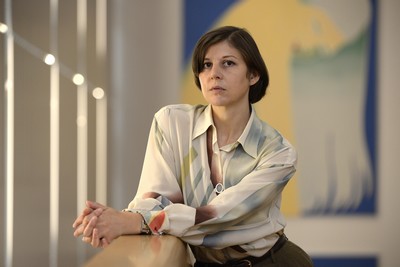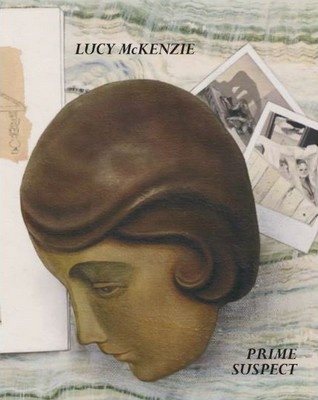Lucy McKenzie – Prime Suspect
Museum Brandhorst, Munich
Through 21 February 2021
in front of the work "Mooncup" (2012)
in the exhibition "Lucy McKenzie -Prime Suspect"
© Lucy McKenzie. Photo:Robert Haas
“Lucy McKenzie – Prime Suspect” is the first international survey exhibition of the Brussels-based Scottish artist Lucy McKenzie (b. 1977). Bringing together approximately 80 works dating from 1997 to the present, the exhibition brings together examples from all of the artist’s significant bodies of work. From her early works exploring the pageantry and iconography of international sport and the politics of postwar muralism, through her engagement with fin-de-siècle architecture and interior design and mid-century Belgian illustration, to her ongoing research into the intertwined histories of fashion and retail display, Lucy McKenzie has established herself among the most singular artistic voices of her generation.
In “Top of the Will” (1998-99), one of the earliest works in the exhibition, Lucy McKenzie combined staged photos of herself and her friends, dressed in gymnastics uniforms based on those worn by the Soviet teams of the 1970s, taped directly to the wall and interspersed with pages torn from vintage books and magazines. In its combination of fact and fiction, documentation and imitation – and a mode of presentation that simultaneously evokes a teenager’s bedroom décor and the “evidence wall” familiar to viewers of countless police procedurals – “Top of the Will” already introduces a combination of fanlike enthusiasm and forensic analysis that is among the most enduring features of Lucy McKenzie’s oeuvre.
Over the past two decades, Lucy McKenzie has excavated and transformed images, objects, and motifs from a wide range of historical moments and contexts, producing a body of work that defies easy categorization but that is, for that very reason, all the more compelling. She has revived the old tradition of trompe l’oeil painting—whose images are so convincingly real that they literally “deceive the eye”—using it as a means to inhabit, critique, and reimagine earlier styles and periods of art and design, illuminating an alternative history of modern art in which the so-called “applied arts” emerge as key players in a narrative that diverges from the established chronologies of modernism and the avant-garde.
Despite her own formidable skills as a painter, Lucy McKenzie has consistently refused to privilege one form of visual or material production over another, often highlighting vernacular and collaborative practices that have historically been marginalized or denigrated in the context of the fine arts. The large-scale installation “Interior” (2007) and the monumental painting “Ludwig Haus” (2009) each synthesize a variety of fin-de-siècle interior designs by Charles Rennie Mackintosh, Victor Horta, and others, enlarging small watercolor sketches and presentation drawings to one-to-one architectural scale. Despite this massive shift, through which they become both paintings and environments, each work nevertheless retains the provisional qualities of its sources. More recently, Lucy McKenzie has mined such seemingly disparate veins as the visual rhetoric of cartography and advertising, while expanding her ongoing series of trompe l’oeil “quodlibet” paintings from pinboards and tabletop arrangements into three dimensions, further destabilizing the relationship between the thing depicted and the thing itself.
The politics of gender and the place of women and the representation of the female body in twentieth century art, architecture, and fashion is also a major theme that runs throughout the exhibition. Where the early painting “Curious” (1998) highlights the eroticization of female athletes in popular media, “Copy of Untitled, 2005” (2014) speaks to the banality of sexual and pornographic content in contemporary culture. “Co? Në!” (2004) imagines a 1960s-era mural advertising a fictional ladies’ deodorant, while “Mooncup” (2012) presents an enormous (unauthorized) advertisement for a real British maker of silicone menstrual cups. Such recent works as “Vionnet Salon Murals after Georges de Feure” (2016) and “Rebecca” (2019) take up the legacy of the early French designer Madeleine Vionnet, known for the mathematical precision of her garments, with construction details often executed to create decorative effects, thereby obviating the need for additional ornament.
Fashion and its dissemination and display are the central concerns of Atelier E.B, Lucy McKenzie’s ongoing collaboration with the Scottish designer Beca Lipscombe. Originally founded in 2007 as an interior design firm, by 2011 Atelier E.B had morphed into a successful line of ready-to-wear fashion employing the highest quality Scottish materials and artisanship. It has also come to function as a kind of artistic research bureau investigating the history of fashion as well as the history of display, from Worlds’ Fairs and heritage exhibitions to department stores and retail showrooms, presenting their findings in the form of exhibitions and publications. Atelier E.B’s fundamentally hybrid nature is exemplified by the architectural work “Faux Shop” (2018), acquired by the Museum Brandhorst in 2019, which functions simultaneously as a showcase for their Jasperwear collection and as an enormous trompe l’oeil sculptural installation in its own right.
The title of the exhibition, “Prime Suspect”, alludes to the way that Lucy McKenzie’s exhibitions often function like detective stories, in which a fictional premise provides the structure for her own investigations, using historical material to ask important and resonant questions about contemporary society. It also points to her own elusiveness in the process – in which the artist herself has a way of disappearing into the dense web of references she weaves in her work – and the challenges this poses to the traditional model of the solo exhibition. Beyond the sheer variety of her output, the formal variation from one body of work to the next can be disconcerting. Her technical dexterity has allowed Lucy McKenzie to develop a methodology that involves taking up and temporarily inhabiting the styles of other artists and periods. In so doing, however, she operates more like a pathologist or method actor than a counterfeiter or forger: for McKenzie, imitation operates not as a form of deception but as a means of understanding her subjects (whether individuals, movements, ideologies, or some combination thereof): of getting inside their heads and figuring out what makes them tick. Similarly, her frequent use of existing historical material differs importantly from the model of appropriation familiar from the art of the 1980s, where artists often sought to undermine the authority of their sources and their claims to authenticity. Rather, Lucy McKenzie herself performs the role of the detective, uncovering and rearticulating overlooked details from the past in order to reveal something of the social relations involved in their production, as well as what made them compelling in the first place, and thereby to better understand those relations in the present.
The exhibition is accompanied by an extensive and profusely illustrated catalogue, documenting the full range of McKenzie’s oeuvre. It includes new essays by Mason Leaver-Yap, Leah Pires, Anne Pontégnie, and Jacob Proctor, as well as a short story by Lucy McKenzie. 350 pages, 282 color illustrations. Published by Museum Brandhorst in collaboration with Walther König. Language: German & English. ISBN 978-3-96098-852-6
Curator: Jacob Proctor
MUSEUM BRANDHORST
Theresienstraße 35a, 80333 München


